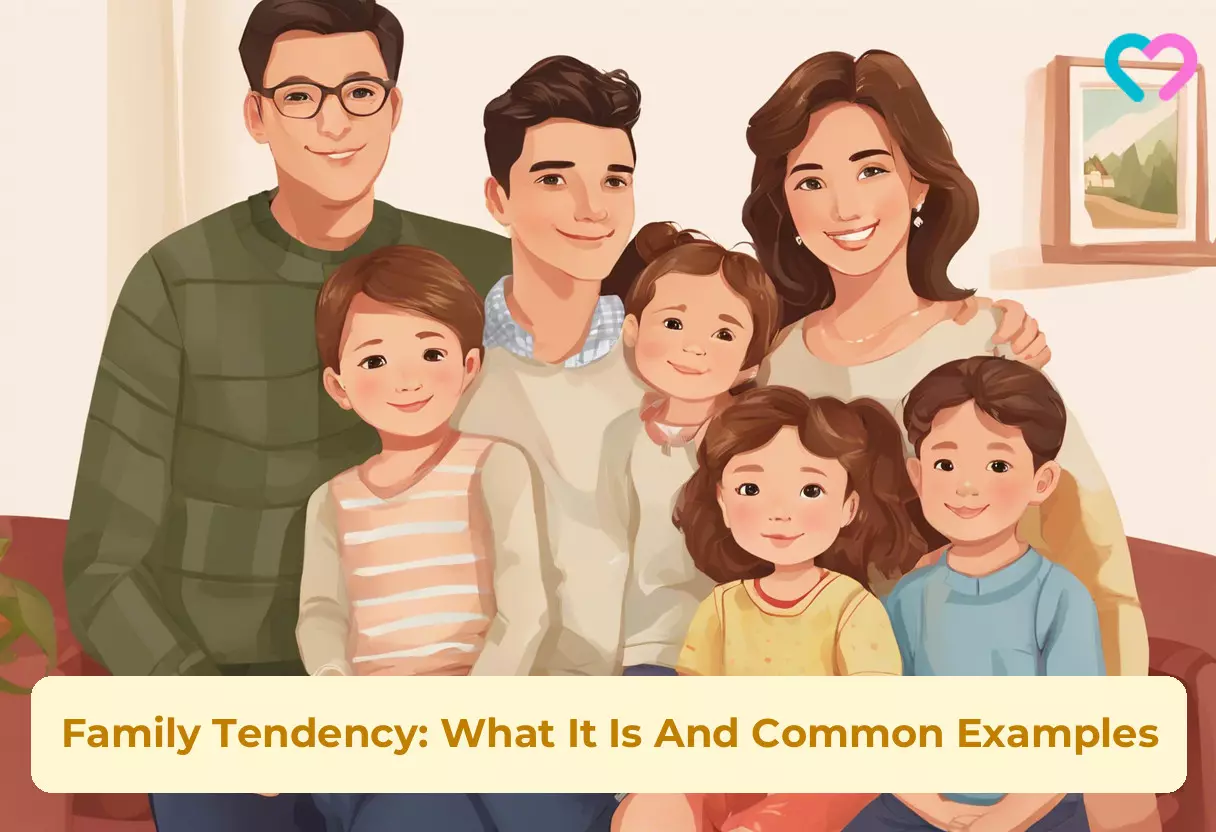
Image: Shutterstock
An old saying, ‘Like father, like son,’ reflects the family tendency concept quite well. A family influences one’s personality and is the backbone of every individual, and the family traits explain a person’s thinking and behavioral patterns. Hence, having some knowledge about family tendencies can help you predict or analyze people’s idiosyncrasiesiA peculiar trait or a behavioral pattern unique to an individual. , and it even helps you anticipate the diseases one is experiencing. Keep reading the post to get an insight into this concept.
Key Pointers
- A family tendency is the way people of a particular family behave and respond or may have a similar inclination to some food, activities, routines, etc.
- Family tendencies are different from familiar traits as the latter have a genetic predisposition.
- These tendencies can be positive or negative and can be learned or acquired.
What Is Family Tendency?

The family tendency is the behavioral and responsive pattern of a particular family and lineage. It is the inclination of all members of one family towards certain things, beliefs, and actions. Usually, eating habits, lifestyle, routine activities, outlook on space, religious orientation, materials, and contemplation are similar in one family (1). Also, family tendency influences a child’s developmental domain as individuals learn to behave according to their environment (2).

The family tendency can influence a person’s life and personality in many ways (2) (3) (4) (5):
- The characteristic way of thinking, judging, attitude, and norms.
- Even if one decides not to repeat their family tendency, they instinctively repeat the same cultural perspective and responses.
- Every family has its distinctive characteristics, dynamics, motives and mindsets, influencing young members’ outlook on themselves and the world. Some influence is helpful, and some are detrimental to one’s behavior, relationships, and perspective.
- Economic factors also impact the family tendency. For example, a family that barely meets the necessities can develop a tendency of starving or a preference for low-priced accommodation and are prone to malnutritioniA condition which occurs when the body fails to get sufficient nutrients due to improper diet or other medical conditions. and diseases.
- Family tendencies bound individuals from personal habits, anxious behaviors, professional and occupational inclinations to volunteering for events, owning pets, and health issues.
It’s said that “you are what you eat.” Similarly, you may become a person as your family tends to be. Though in some exceptional cases, individuals develop bad habits or criminal attitudes due to the effect of social or bad company (6).
Family Tendency Examples
Family tendencies can be positive or negative. Let’s consider some examples of family tendencies to understand the concept better.
1. Learning and education

The influence of parents on children regarding academic achievements is immense (7). Educated parents tend to choose better schooling for their children, helping them make better decisions. Also, if a family is good at Mathematics, it is likely for a child to be good too. Similarly, if a family is into singing, the chances of children being into music are bright. However, there are exceptions to every case.
Even research indicates that children with a strong family background are more active in school and have fewer chances of suspension. For example, according to the U.S. Census Bureau, children coming from families having married parents showed better 33.7% involvement in school activities than the 25.7% recorded for children living with a single parent. Similarly, children with married parents were less likely to be suspended than those living with guardians or a single parent (8).

Child wellbeing indicators depending on the family structure
Source: The Link Between Family Background and Academic Success; Institute of Family Studies/US Census Bureau2. Food preferences
Food preferences are often similar among family members because of their shared meals, culture, traditions, and habits. Especially young children develop similar food preferences as their parents or siblings as they start to eat their meals together. Reminiscing about the meal experience with her two sons during their childhood, Grandma Donna says in her blog ‘Down to Earth,’ “They (her sons) both started eating porridge – the same one we enjoyed, then grew up with all of us sitting at the kitchen table for meals; there were no special foods.” She further shares about a particular dish she gave to her sons which was specific to her family. She adds, “I gave them the occasional chop bone to chew on, and they loved them. I think many of today’s mothers might be shocked at the chop bones, but at that time, it was a fairly common practise. The boys happily sat there chewing away, tasting the flavour and getting a very small amount of nutrition. The purpose of the exercise was to get them used to seeing us eat and for them to eat the same food (i).”
However, sometimes, having similar food preferences may have a negative impact too. Some families have a predilection for oily and sweet foods rich in fat and sugar content, leading to obesity in every family member. Such a tendency makes the family prone to habit-induced diseases. To overcome these family tendencies, an individual may have to work hard. Some families are extremely health conscious and follow a strict diet and meal plan, which runs with every member.
 Point to consider
Point to consider3. Language
Children from a household where only one language is spoken may find learning other languages difficult. Similarly, when there is the use of bilingual languages in the family, members tend to use words from both languages, which becomes their family tendency. Studies have also shown that bilingual children are smarter and have more social understanding. These children also have linguistic benefits and added cognitive abilities like swiftly changing between activities, just like they change languages (9).
4. Manners and etiquettes

Some spoken and unspoken norms and customs in families become a part of their culture. These norms are reinforced over how family members dress, speak, and act. Families have regulations for behaviors proposing actions allowed and forbidden for situations. These learned manners and etiquettes guide the individuals to behave in specific scenarios (3).
Thomas Vanboven, one of the board members and the direct family member from the Vanboven Family Foundation, shared his experience of growing up in a family where mannerisms were of great value. He says, “In our family, good manners count for everything. As children, my sister and I learned not to raise our voices, never to ask personal questions, and to avoid dissension at all costs. If we violated those rules, my parents would only have to raise their eyebrows to let us know that our behavior was out of line (3).”
5. Traditions
Traditions are followed in families for generations. Each family has its own unique ways of celebrating and upholding customary practices that are integral to their familial heritage. The execution pattern becomes the characteristic of families and becomes a family tendency (3). For instance, Christmas is celebrated worldwide; however, the way of celebration differs from one community to another, and even between families.
6. Lifestyle

Some health-conscious families may tend to get up early in the morning, do exercises or yoga, consume healthy food, and keep the house and the surroundings clean. Such families are habituated to the perks of healthy living and have an inherent proclivity towards it. However, it might not be the same trend in every family. Children or a family often share their bad habits and lifestyle as well. For instance, many studies show that children of alcoholic parents are four times more likely to develop alcohol problems (10).
7. Perspectives
A family often shares similar perspectives as they are brought together with common values, characters, and attributes. Growing up together as a family influences how they approach a problem, their lifestyle, and even how they perceive things. For instance, some families may tend to earn more and be in power. Some families are content with whatever they have and do not strive to take up challenges or risks. These characteristics could be found in the young members naturally. Similarly, if the elders in a family actively help others, their children and other family members are likely to follow suit by volunteering together or supporting charitable causes, integrating this value in their daily lives.
8. Nationalism and political tendency
Attitudes towards citizenship and beliefs influence one’s political views, nationalism, and patriotism. Hence, it becomes a family tendency until a member has different opinions (11). Lisa Argyle, a political science professor says, “Political science research shows that families are typically the ‘starting point’ for someone’s political views, then, friends, communities, political events and other life experiences can shift people from that starting point, especially in the young adult years.” However, she still believes that if parents talk strongly about their political views at home, the children’s political views will likely reflect their parents’ views as they grow (11).
9. Broken family
Members of a broken family may have commitment and trust issues in their relationships. Children of such families may suffer from stress, depression, frustration, and inferiority complex (12). A 2025 study published in the KnE Social Sciences showed that the likelihood of a child getting depression directly becomes higher with a higher level of family dysfunction (13).
10. Abusive nature

Some families tend to verbally or physically abuse females and children. Such tendencies or temperaments have a profound impact on children in their growing age. They may radiate the absorbed negativity in the form of disrespectful behavior or may have low self-esteem, feelings of abandonment, anxiety, and anger (14). A study further showed that men growing up in patriarchal families, where they have witnessed abusive and violent behavior of their fathers towards their mothers, are more likely to behave in the same ways with their partners (15). Meanwhile, girls living in abusive families may deem this violent behavior of their partner as a normal occurrence as well.
11. Beliefs and taboo
The tendency of conservative nature and thoughts run in families. They may have taboos like restrictions on women’s clothing, educational decisions, and the careers of individuals. Strict rules and regulations with adamant behavior can turn a home into a sophisticated prison, where only a key person of the family makes decisions for all. Growing up in such an environment may tend to have orthodox beliefs, expecting the society to accept their beliefs (3). For instance, in certain families, especially in patriarchal Indian families, discussion about periods and sexuality is considered taboo.
Strategies To Identify And Manage Family Tendencies
Family tendencies are learned or adapted behavior and personality of an individual influenced by the family. While it is good to retain the positive values and manners from the family, negative tendencies should be identified and managed accordingly. Some of the effective strategies that may help include:
- Observing and talking about any recurrent negative behavior or pattern within the family, such as patriarchal beliefs.
- Creating a safe space and encouraging open communication within the family.
- Discussing and asking questions about certain traditions, beliefs, or rules.
- Understanding the origin behind certain beliefs and how it has helped the family.
- Retaining and celebrating positive tendencies like a healthy lifestyle, good manners, and helping nature.
- Challenging and raising voices against toxic traits, like abuse and rigid thinking.
- Encouraging each family member to express and explore themselves as an individual.
- Openly discussing different viewpoints and taking opinions.
- Setting boundaries within the family.
- Work as a family to replace negative habits with positive ones.
Difference Between Family Tendency And Family Trait
The family tendency is about the habits and behavioral patterns of a family. On the other hand, family traits are usually genetic, hence inherited (16). For example, having blue eyes is a family trait, and sleeping late at night is a tendency.
 Point to consider
Point to considerModern luxurious lifestyles with minimal physical exertion can be responsible for lifestyle diseases, but hereditary conditions such as blood pressure or thyroid are family traits (17). An illness or condition present in one family member, having no genetic predispositioniIncreased likelihood of a person to develop a particular disorder due to genetic factors. , affects every family member due to the family tendencies. The family tendency is learned and acquired, unlike the genetic family trait. For example, extreme anger or hardcore criminal mentality could be due to family tendencies (18).
Frequently Asked Questions
1. Why is it important to know my family’s inherited traits?
Knowing about your family’s most commonly inherited genes and genetic history help determine your risk of inheriting genetic disorders (such as heart problems and diabetes) and possible conditions in your family. Nevertheless, acquiring these genes and diseases depends on several factors, including lifestyle choices and the environment (19).
2. Is a family tendency a sure thing?
Although common in most individuals, a family tendency is not a guaranteed phenomenon in all family members. Furthermore, some individuals may develop varied features and habits depending on various factors.
3. How can individuals and families manage their risk of developing health conditions related to family tendencies?
Educating yourself about the condition, monitoring symptoms, maintaining overall fitness, ensuring regular health check-ups, performing necessary screenings, and detecting any early signs of potential conditions can help manage hereditary conditions.
4. How can family tendency impact decisions around family planning and pregnancy?
Family or genetic tendencies can significantly impact decisions around family planning and pregnancy. Families with a history of specific health conditions, such as diabetes, heart disease, or certain types of cancer, may consider these factors when making decisions about family planning.
5. Are there any ethical concerns around genetic testing for family tendencies?
Genetic testing involves the collection and analysis of highly sensitive personal information. There are concerns about the security and protection of an individual’s genetic data, as it can reveal information about the tested individual and their family members.
The family tendency is responsible for influencing a person’s outlook and way of thinking about themselves and the rest of the world. Food habits, lifestyle patterns, and beliefs are certain examples influenced by family tendencies. These environmental factors affect children’s development as well in a household. You should note that family tendencies cannot be interchanged with family traits. Harmful family tendencies can be changed with the help of the support and determination of the whole family, and you should carry forward the good tendencies for a better quality of life.
Infographic: Common Family Tendencies
It’s common to pick on the habits and nature of family members when living together. These tendencies differ among families and can occur across generations in a family. Read through the infographic below as we list common examples of tendencies that family members generally share.
Some thing wrong with infographic shortcode. please verify shortcode syntaxIllustration: Family Tendency: What It Is And Common Examples

Image: Stable Diffusion/MomJunction Design Team
Delve into sociology’s family definitions, diverse family types, and marriage across societies. Check out this video to explore residential and descent patterns, plus three schools of thought on marriage and family’s societal roles.
Personal Experience: Source
MomJunction articles include first-hand experiences to provide you with better insights through real-life narratives. Here are the sources of personal accounts referenced in this article.
i. Children and parents eating the same mealshttps://down—to—earth.blogspot.com/2013/05/children-and-parents-eating-same-meals.html
References
1. The Factors That Influence Our Food Choices; Food Facts For Healthy Choices (2006)
2. The Role Of Family In Child Development; Children’s Bureau (2017)
3. The Effects Of Family Culture On Family Foundation; Council On Foundations
4. B Abbas Al Ubaidi; Cost of Growing up in a Dysfunctional Family; Journal of Family Medicine and Disease Prevention (2017)
5. R D Conger, K J Conger, and M J Martin; Socioeconomic Status, Family Processes, and Individual Development; Journal of Marriage and Family (2010)
6. J Waldroop and T Butler; Managing Away Bad Habits; Harvard Business Review (2000)
7. A J Egalite; How Family Background Influences Student Achievement; Education Next
8. The Link Between Family Background and Academic Success; Institute for Family Studies
9. Krista Byers-Heinlein and Casey Lew-Williams; Bilingualism in the Early Years: What the Science Says; LEARNing landscapes (2013)
10. Family History of Alcoholism: Are You at Risk?; Los Angeles Country Department of Mental Health
11. K Holbrook; How family and religion influence young adult political views; The Daily Universe (2025)
12. S S Jogdand and JD Naik; Study of family factors in association with behavior problems amongst children of 6-18 years age group; International Journal of Applied & Basic Medical Research (2014)
13. Cholifah Utaminingtyas et al.; Family Dysfunction and Depressive Tendencies in Adolescents; KnE Social Sciences (2025)
14. Family violence explained; Better Health Channel; Victoria State Government
15. Zareen Nishaat Beebeejaun-Muslum; Gender Relation, Patriarchal Control, and Domestic Violence: A Qualitative Study in Mauritius; European Journal of Humanities and Social Sciences (2025)
16. What is inheritance?; Your Genome
17. Q Qibin et al.; Genetic Predisposition to High Blood Pressure Associates With Cardiovascular Complications Among Patients With Type 2 Diabetes; American Diabetes Association (2012)
18. D Garcia-Arocena; The Genetics Of Violent Behavior; The Jackson Laboratory (2015)19. D Garcia-Arocena; Why is it important to know my family health history?; MedlinePlus
Community Experiences
Join the conversation and become a part of our nurturing community! Share your stories, experiences, and insights to connect with fellow parents.
Read full bio of Bharat Sharma
Read full bio of Shikha Thakur
Read full bio of Akshay Nair
Read full bio of N Pravenchandra Singh
















